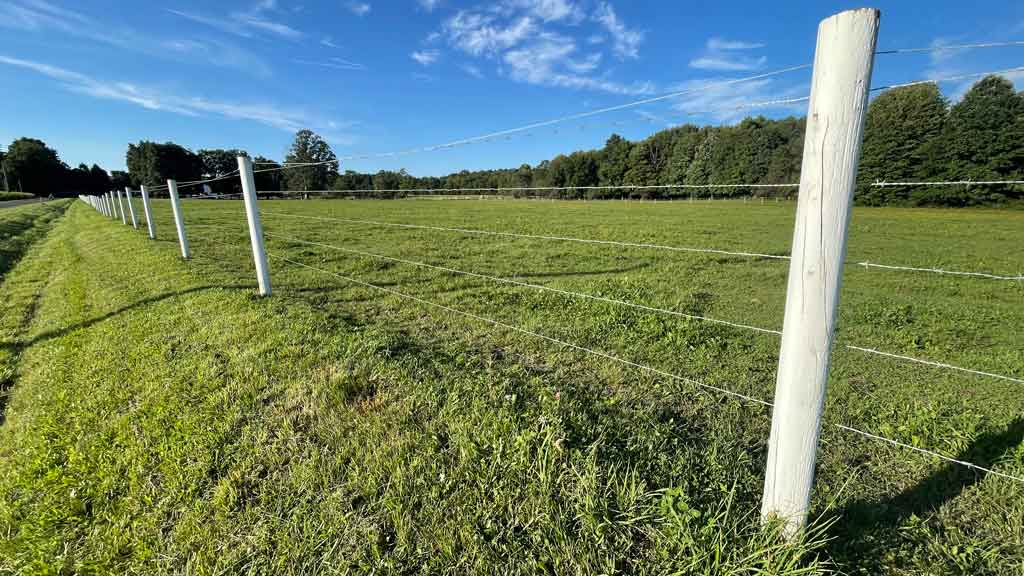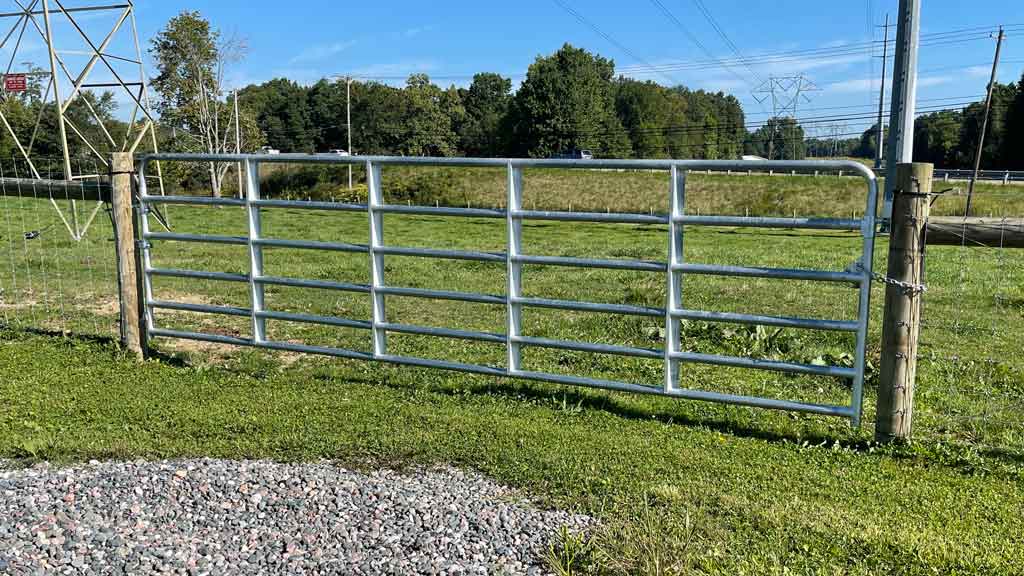Many factors determine the type of cattle fence you should choose. Cattle need lot’s of room for grazing. As a result, you will need lots of fencing materials.
Protecting the herd and keeping them contained is the number one job of the fence. Doing so without spending a small fortune is the goal.
The size of the fenced area will have a lot to do with the cost of the fence. Therefore, it will most likely also influence what type of cattle fencing you choose.
In order to help you make a wise decision, let’s take a look a some cattle fence ideas and discuss the pros and cons of each one.
Types of Cattle Fencing Options
There are many types of livestock fencing designs to choose from. On the simple end of things is an electrified strand of high tensile wire.
More elaborate are wooden corral style board fences. But which fenceing type is right for you? Ultimately it will be your decision. My job is to give you the information needed to make that decision.
Electric Fencing for Cattle

Electric fences for cattle is simple by design. A perimeter of high tensile wire is installed. One or two strands is the most common configuration. The wires attach to a box which provides an electric current.
Known as charging units or fence energizers. Charging units and energizers come solar powered or plug into a power source. Joules are the unit of measurement for the amount of current provided by the charging unit.
The length of the fence will determine the total amount of joules needed. Therefore, the longer the fence, the more joules required.
Electric fences are affordable and easy to install. However, it does have some drawbacks.
Poor grounding is one of the main problems with electric fences not working correctly. Very rocky ground and very dry ground can result in poor grounding of the fence. Poor grounding results in a weak shock or no shock at all.
Fallen trees cause breaks in the fencing rendering them useless. As a result, open spaces and pastures are better areas for electric fences for cattle. It is also easy to pull up and reinstall if needed.
Accidental damaged is another drawback. Cattle cannot see the the thin strands of wire well. Especially in the dark. Sometimes stampeding cattle accidentally break electric fencing without knowing it.
Predator control is another drawback to electric fence for cattle. Using one or two strands of wire leave big gaps between them allowing small animals. As result, predators can easily pass through allowing access to the herd
Barbed Wire Fencing

Barbed wire fencing is a popular style of livestock fencing. Like electric fencing, it is easy to install and affordable. 5 strands is the most common configuration. However, anywhere from 4 to 6 strands is acceptable.
It flows over uneven terrain well. It is good for long lines of fencing covering lots of ground. Because the twisted metal barbs are a deterrent to cattle, there is no need to electrify it.
Barbed wire fencing is also prone to tree damage. However, it is easy to to fix with basic fence pliers.
Sometimes, the thin strands of wire used to manufacture barbed wire can break overtime. This can be as a result of the high amounts of tension used to stretch it tight or when it rusts through.
But at less than $100 per roll for over 1,000 feet, having extra on hand for the occasional repair won’t set you back financially.
Minor injuries to cattle can be a concern to some. The barbs are sharp. Made to poke and slice. So cattle sometimes get cuts and scrapes from brushing against it.
These could cause infection. Especially from very rusty barbed wire.
Woven Wire Cattle Fences

Woven wire cattle fencing comes in many different configurations. Fence height, gauge of wire, and size of the holes are just a few options to choose from.
Woven wire is different than welded wire. Heavier gauge strands of wire are used. A special knot ties the strands together where they intersect. Allowing it to stretch tighter than welded wire fencing.
It also allows the intersecting joint to flex. As a result, it follows uneven terrain much better than welded wire.
The gaps or spaces in woven wire cattle fence come in different sizes. Some mesh sizes stay constant from top to bottom. While others start off smaller at the bottom and gradually increase in size towards the top.
The smaller gaps prevent small animals from entering or existing the fencing when contained in the same pasture as cattle. This is useful for farms that also have smaller animals such as goats and sheep.
Wood Cattle Fencing

Corral style fence and crossbuck are styles of wood cattle fence. However, wooden fence is more costly when compared to wire fencing. As result, used for smaller pasture and or paddocks.
One advantage wooden fence has over wire cattle fence is the visual element. The thicker boards give cattle a visual reference wire fencing doesn’t.
This helps in preventing accidental injury to cattle. Pastures and fields lined with wood fence also give farms and ranches that classic look.
However, maintenance is a factor with wood fencing. Painting and staining is a daunting task. Large cattle can easily break the horizontal rails used to build wood cattle fence. Although, adding a hot wire will help prevent cattle from breaking rails.
But, there will always be maintenance and upkeep. It is not uncommon to use wood cattle fence along roadsides and closer to barns, then switching to wire fencing to fill out the remainder of the fenced in areas.
Cattle Fence Panels

Cattle fence panels are much stronger than other types wire fence and much easier to install. Thick gauged wire strands welded together from the panels. As result, they do not need stretched like other wire fences.
This eliminates the need for heavy end and corner posts with bracing. Steel “T” posts or star pickets driven into the ground hold cattle panels in place.
However, attaching them to heavier wood posts is better for more permeant solutions.
Cattle fence panels are great for temporary corals and paddocks. Allowing easy removal and relocation when needed. They are the only fence that style that allows for this.
Another bonus when using cattle panels is you don’t need a to purchase a gate. Panels remove easily to allow access. No gate or gate posts are needed.
Post Options for Durable Cattle Fence
Farmers and ranchers have used many types of materials to make fence posts. Wood, steel pipe, “T” posts, star pickets and trees are all used as posts.
Whether the fence is permeant or temporary will determine how many and what kind of posts to use. The style of cattle fence will also be a determine factor.
End Posts, Corner Posts and Bracing

This is where most people screw up. They don’t use heavy enough posts or they don’t set them deep enough into the ground.
The integrity and strength of any fence comes from the end and corner posts. Especially wire styles of fence that need stretched.
Bracing is just as important for a durable cattle fence. A horizontal brace connecting the end or corner post to the first line post is a must.
A truss tightening system made from tension wire is also a needed. It is crucial to have rock solid end and corner posts in order to keep tension on stretched wire fences.
Wood or galvanized steel pipe are most common for end and corner posts. Don’t be afraid to go overboard here. Use a larger post diameter than you think.
Dig it a little deeper than you think. Soil density is different across the country. So there is no standard depth.
However, 48″ deep should work for most applications. Preventing pulling from tightly stretched wire and heaving from freezing ground.
Support Post for Livestock Fencing
Support fence do not have to be as strong as the end and corner posts. As a result, all types of materials are used. Wood is a must for board style fence. Allowing horizontal rails to fastened to them at 8′ intervals.
“T” posts and star pickets are common for barbed wire and woven wire support posts. Post spacing of 16′ on center is standard.
However, in ares with uneven terrain the spacing should be closer. High tensile fence can have post spacing of 50′ to 70′ between them.
Normally a metal “T” post with an insulator between the post and wire to prevent grounding. Cattle panels use both wood and “T” posts depending on the strength needed.
Cattle Fence Gates
There are only a couple good options when choosing a gate for your cattle fence. And one bad option.
The bad one is wood. Don’t use a gate made from wood. They are heavy and cumbersome. They will sag and require maintenance.
It just isn’t worth the effort. The other two options are metal farm gates and making a barbed wire gate.
Metal Farm Gates

Galvanized Tube Style Farm Gate
I’ve hung every kind of gate known to man. A metal farm gate is simple to hang, easy operate and fairly in expensing. They are relatively light in weight, yet extremely durable.
However, they do require a strong gate post to hang from in order not to sag. Wood or steel are both good. Set them deep like end and corner posts. Adding concrete helps keep gate posts straight and plumb.
Metal farm gates come in single panels up to 16′ wide. However, combining two to make a double gate will be much more user friendly if the gate will be open and closed often.
If gaps between the rails are a concern, there are farm gates available with welded mesh or cattle panels to them. This prevents smaller animals from squeezing between the rails.
Barbed Wire Gates
Barbed wire gates require building from scratch. They are not available for purchase. They combine the strands of wire used for the fence and round wood posts or logs.
When stretched between gate posts, barbed wire gates look like the rest of the fence. Chances are you will already have the materials on hand.
The advantage of a barbed wire gate is the distance they can cover. Openings of up to 30′ wide can be covered by one gate.
Conclusion
Many factors influence the type of cattle fence that will work best for your personal situation. The size of the area is the biggest factor when choosing a fence type. As a result, effecting the overall upfront cost of the project.
Wire strand cattle fences like barbed wire and high tensile will allow you to cover more area at a lower cost. Wooden style fences will cost more, but are safer for the heard. Providing a more visual barrier.
You should choose the style and design that fits your needs the best. Providing a safe and secure enclosure is the number one priority.
For more options and ideas on cattle fences check out our Wooden Farm Fence Designs article. It covers more styles of wood farm and ranch fences that are also used for containing farm animals.

